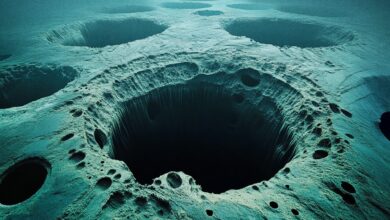Scientists Made A Mysterious Discovery Buried Deep Underground Where No Human Has Been

A mysterious metal library has been discovered in a cave in Ecuador, containing many gold metal plates engraved with strange symbols, possibly related to an ancient civilization or aliens. Father Carlos Crespi, an Italian missionary, collected more than 50,000 artifacts from local people. However, most of the collection was destroyed in a fire in 1962 or disappeared after his death in 1982. Some experts later concluded that many of the artifacts were fakes or crudely crafted, but reports from the 1970s still refer to the mysterious metal plates, raising many unanswered questions.
In Egypt, archaeologists have found a complex underground tunnel system designed to simulate the journey to the afterlife according to ancient beliefs. These underground chambers contain carvings from the “Book of the Dead,” a sacred document that guides the souls of the dead on their journey through the trials of the afterlife.
In Thailand, researchers discovered a new species of venomous pit viper in a cave, notable for its vibrant colors and aggressive nature. The discovery is a major addition to the biodiversity of the region.
The ATM (Actun Tunichil Muknal) Cave in Belize has revealed many ancient Maya sacrificial artifacts, including the famous “Crystal Maiden,” a skeleton covered in sparkling crystals. The findings shed light on the sacrificial rituals and mystical spirituality of the Maya civilization.
**Pan’an Dong and Gangi Province**
Radiocarbon dating suggests that Pan’an Dong was a center of activity at least 300,000 years ago, possibly as long as 700,000 years, predating the emergence of modern civilizations. In nearby Gangi Province, fossils of the giant ape *Gigantopithecus blacki*, which stood 10 feet (about 3 meters) tall and weighed more than 1,200 pounds (550 kg), have been discovered. The species lived alongside prehistoric humans in Asia, but disappeared about 100,000 years ago during the Ice Age.
**Movile Cave (Romania)**
Movile Cave, isolated for 5.5 million years, contains a unique ecosystem. It is home to 48 species of creatures, 33 of which are found nowhere else. They are blind, lack pigments, and rely on chemosynthetic bacteria – bacteria that get their energy from chemical reactions, rather than sunlight. Scientists believe the creatures became trapped in the cave when layers of limestone sealed off their exit. The cave also offers an opportunity to study the survival of life in extreme conditions.
**Golden spheres under Mayan pyramid**
In 2023, researchers explored a secret tunnel under a Mayan pyramid in Mexico and discovered two mysterious golden spheres encased in a metallic sheen. They were made of clay but had a gold-like coating, suggesting a ceremonial or astronomical purpose. The walls surrounding the tunnel contained shimmering gold streaks, possibly representing the cosmos. This fits with the sophisticated astronomical knowledge of the Maya, as recorded in the *Dresden Codex*.
**Batti Fratta Cave (Italy)**
In Batti Fratta Cave, Italy, a 7,000-year-old female clay figurine was found, which may be related to agricultural or fertility rituals. The figurine has a simple face but elaborate decorations in her hair and body, suggesting cultural importance. In addition, other artifacts such as animal and plant bones and a human skeleton suggest that the cave was used for both domestic and ceremonial purposes. The discovery is consistent with Neolithic rituals and art in Northern Italy.
**Lava tube art in Saudi Arabia**
In a lava tube in Harat Khaybar, Saudi Arabia, archaeologists have discovered ancient artwork by pastoralists from 7,000 years ago. The carvings depict goats, sheep and signs of human activity, reflecting the cultural life and connection with nature during that period.
Taken together, these discoveries provide insight into the diversity of ancient life, from isolated cave ecosystems to unique human cultural and ritual imprints.
**Arabian Caves with Ancient Art:**
Researchers have discovered ancient stone tools and stone structures and rock art in lava caves in Arabia. In particular, in Un Jeran Cave, they found traces of domestic sheep and goats from the Neolithic period. In a collapsed entrance, they discovered 16 rock art panels, dated to 5,000–7,000 years old, depicting scenes of people and livestock, especially grazing with dogs, which is rare in the area. This art suggests that the caves may have been resting places for herders.
. **Derinkuyu Underground City, Turkey:**
The Derinkuyu Underground City, discovered by accident in 1963, is located 85 meters underground and has 18 floors. Built by the Hittites in the 15th century BC as a refuge from invaders, the tunnels led to schools, houses, workshops and underground water sources. The city was protected by trapdoors and narrow passageways. Although much of it is now submerged, it still holds a curious place for researchers and visitors.
**Cave in Guildford, England:**
Workers discovered a cave near Guildford that dates back to the 14th century. It may have been a shrine attached to St. Catherine’s Chapel on a nearby hill, once known as “Dragon Hill.” The cave contains ancient inscriptions and traces of sacrifices, suggesting religious or ceremonial activity. Scientists are currently studying ancient charcoal ash in the cave to further unravel its history.
**Znojmo Tunnel System, Czechia:**
The Znojmo Tunnel System was built in the 14th century to protect its inhabitants from enemies. It connects basements with fire escapes and contains traps to distract intruders. Although much of it is now submerged, it is still impressive for its defense mechanisms and mystery.
**London Underground Network, UK:**
Underneath London lies a secret tunnel system of some 25 million miles, built largely during the Cold War by government agencies to protect against the threat of nuclear war. Some of the tunnels have been resold and converted into hotels, but most remain out of reach of the public.
**Kid Mine in Canada – Underground Galápagos:**
Kid Mine, located nearly 8,000 feet underground, contains the world’s oldest water (2 billion years old) and a strange ecosystem of single-celled organisms that live on sulfur and pyrite ore. The discovery suggests the possibility of alien life.
**Inca tunnel system in Cusco, Peru:**
The modern city of Cusco was built on the ruins of ancient Cusco. Secret tunnels connect the city to ancient temples, such as Qorikancha, which were destroyed by the Spanish. However, excavations have been hampered by the historical structures that overlap.
**Neanderthal stone rings in France:**
In a cave in France, scientists have discovered stalactite circles that are 175,000 years old. These may be the oldest structures built by Neanderthals, suggesting they had very early planning and construction techniques.
**Underground vault under Halifax, Canada:**
A mysterious underground chamber discovered under the Halifax County House, which may have been an 18th-century ammunition dump, contains ancient ceramic artifacts, but due to its complex location, researchers can only survey it from a distance.
**Margate Shell Cave, UK:**
The Margate Cave, decorated with 4.6 million shells, is a mysterious 19th-century work of art. It is unclear who built it or for what purpose, but its beauty and intricacy make it a unique attraction.








